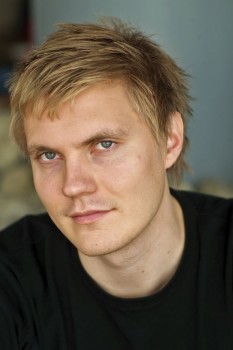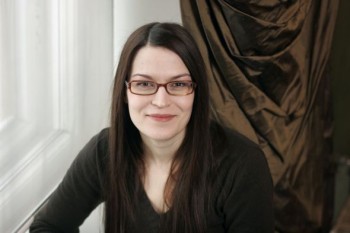Writing silence
6 June 2013 | Fiction, poetry, Reviews
In contemporary poetry the ‘lyric I’ of previous decades often hides behind language; the poem’s speaker is not the poet him/herself, narrative is not the norm. The website of a Finnish family magazine in 2007 discussed this: ‘OMG, this thing called contemporary poetry – crap!’; ‘Who knows what kind of psychopharma the writer’s on!’; ‘No meanings, just words one after the other. Why can’t people write something sensible?’ But the writer – and the reader – of contemporary poetry deliberately ventures onto the boundaries of language, and art requires readers (listeners, viewers) to make the decision of what they consider ‘sensible’. Mervi Kantokorpi explores and interprets two new collections of poetry
I read two of this spring’s new collections of poetry one after the other: Kivirivit (‘Stone lines’, Otava 2013) by Harry Salmenniemi and Pysty hiljaisuus (‘Vertical silence’, Teos 2013) by Miia Toivio. The experience was perplexing.
These two works are completely different from one another as regards their individual poetics, and yet the similarities between the themes that arise from them was arresting. Both works seem to inhabit an internal world of sorrow and depression, a world where the function of poetry is to forge and show its readers a path out of the anxiety. In their silence – and even emptiness – both collections have two faces: one lit up, the other darkened by grief.
What’s the matter, what’s happened to you? This is the reader’s spontaneous but rhetorical question in face of this poetry. In response, all we have is indirect talk of poetry and writing as the means of resolving human paradoxes. The themes in these works are strongly metalyrical. Though they deal with speaking subjects they also deal with poetry itself, and above all with language, perhaps our only connection to one another.
These poems speak of the possibility and impossibility of speech; this theme is developed and realised in two excellent and very different manners. Salmenniemi (born 1983) and Toivio (born 1974) are contemporary poets in the sense that both are interested in the experimental nature of renewed poetic language: in their earlier works both have actively sought out new modes of expression.
It is fascinating to note that they now address the question of the poetic subject, a heated debate in the contemporary discourse. Public work in the poetic field is also important to these poets; both have served as editor-in-chief of Tuli&Savu (‘Smoke&Fire’), the most significant poetry magazine in Finland.

Harry Salmenniemi. Photo: Irmeli Jung
Salmenniemi’s poems feature a first-person subject, an ‘I’, but who is it? The speaker’s status is confusing, as in his earlier procedural works Salmenniemi has often blurred the identity of the traditional poetic speaker, making it more polyphonic and anonymous, for instance by using material generated by search engines. Now, however, the more ponderous tone leads us towards a stronger interpretation of the role of the speaker.
Kivirivit is a series of seven extended prose poems, though its narrow layout makes the text look more like columns of verse. This too is trompe l’oeil, as the individual lines are not a fundamental structure of the poetic expression here, rather calm sentences carry the text forwards one clause at a time. And more importantly, it seems as though no narrative emerges.
Small entities a couple of sentences long seem to interact with one another: they are like neo-aphorisms, crashing words together to form new meanings. Behind this may be the ‘New Sentence Technique’, created by the American poet Ron Silliman (born 1946), here adapted for the needs of prose poetry. Sentences struggle against the narrative tendencies of prose by moving away from referentiality.
The work gains a sense of continuity through a series of repeated elements. Every poem begins with the words ‘Then, not now’. The chain of clauses and sentences progresses through the interplay of memory and observation. Language and mind digress, but no unifying story ever emerges because the text breaks down structures of narrative logic.
As the poem suggests, reading becomes writing: ‘Don’t read this, write this.’ The speaker’s mind is filled with the straining conditions of everyday life. Human relationships, separations, and the mere fact of being are like heavy burdens not alleviated by living as an artist.
The idea of the work is of speaking through all the repeating elements, rewriting them, writing on top of them, emptying them, dismissing them. Salmenniemi’s collections of poetry have always been ‘total’ works of art. Graphic designer Markus Pyörälä has designed the book to look like a passe-partout frame: through a gap we see writing that has been written over time and again. The graphic layout emphasises the poems: the objectification of the book is reduced to a minimalist aesthetic, always referencing itself, its own pure presence.
A world of states of mind, spoken away, written and wiped away, develops into an intense, reverent silence whose meaning lies in the art of meditation. The sheer emptiness of Salmenniemi’s poetry is powerful and the source of all energy.

Miia Toivio. Photo: Heini Lehväslaiho
Contrastingly, Miia Toivio has openly explained the philosophical background to her work through numerous quotes and references: influences include the German 17th-century mystic poet Angelus Silesius, the French writer-philosophers Maurice Blanchot and Julia Kristeva, the latter’s texts providing a quotation that opens the first poem:
“‘I speak, but I speak at the edge of my tongue”, she said, “at the edge of my skin,” she said, “I have very small fingers, with those,” she said but cut herself short. I wanted to listen to her, but she wouldn’t speak. She never did exchange her yellow fruit for violet. For a moment she pondered the lemons, the plums. For a moment I let her ponder the lemons, the plums. She felt for her contours too, then began to sink. I didn’t like the way she expressed herself, didn’t like her small fingers, but I did like them all the same: small fingertips cupped around a fruit.’
Kristeva’s seminal work Soleil Noir (1987, in English, The Black Sun: Depression and Melancholia) speaks of melancholy and depression, at the root of which is the tragedy of humans’ being born into a world of language. Children are removed from the ‘mother’, i.e. from a symbiotic and semiotic relationship in which language and body are one, and turn towards the ‘father’ or the ‘father’s name’, i.e. to symbolic meaning (language). This is then followed by a separation, a divorce from the original state. For Kristeva, art is an endless attempt to close the gap, to heal the wound of that separation. For Toivio, poetry fulfils a similar function, but this is equally the case for Salmenniemi too: emptying, purging by writing away, a meditative silence.
On a formal level, Pysty hiljaisuus is also a process-driven work in which the reader moves from the straight columns of prose text at the beginning to the ragged, edgy verse structures of the final two sections. The work begins with a subject–object binary, at the heart of which is the disintegration of the subject; the subject seems to speak to herself, to different aspects of her own being. At the same time she is also searching for an unknown universal other, towards which she is travelling.
In Kristevan terms, depression condenses into an alienation from language, an inability to communicate. Toivio’s poems intensely strive to form connections with the other, to correct and complete one another, to repeat endlessly what has already been said, to find new meanings in language and its relationship with the surrounding world. Talk of ‘the edge of my skin’ grows to represent a corporeality of sorts; the poems seem to yearn for a synthesis of body and language, to close the gap between them, to restore the symbiosis.
Blanchot’s notion of the paradoxical nature of language is beautifully expressed in Toivio’s poems: on the one hand language is an instrument of power and violence, on the other it is the only way for humans to connect with one another. The title of this collection is like a creature representing both danger and possibilities. Eventually the poems’ duality culminates in a beautiful depiction of the forest in the manner of Baudelaire, or the great temple of Finnish symbolism; the sketchiness and the incompleteness of human life redeemed there: the spacious, simplistic silence of the forest.
Translated by David Hackston
Tags: language, philosophy, poetry
No comments for this entry yet
Trackbacks/Pingbacks:

21 December 2013 on 11:39 am
[…] (aus Kivirivit, Otava 2013. übersetzt von David Hackston. ein längeres zitat dieser passage ist auf der homepage Books from Finland veröffentlicht. dort findet sich auch eine englischsprachige kritik des buchs). […]